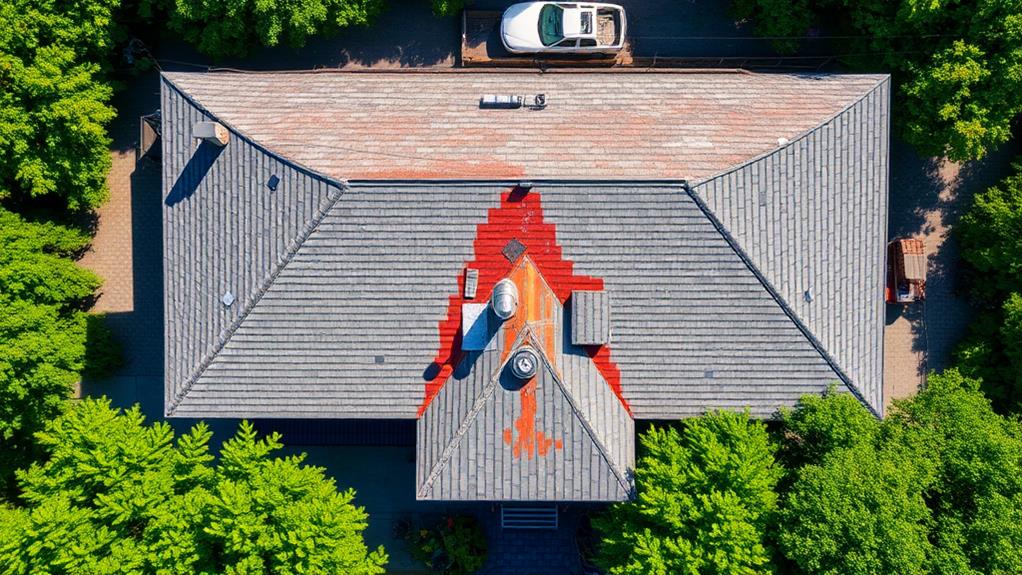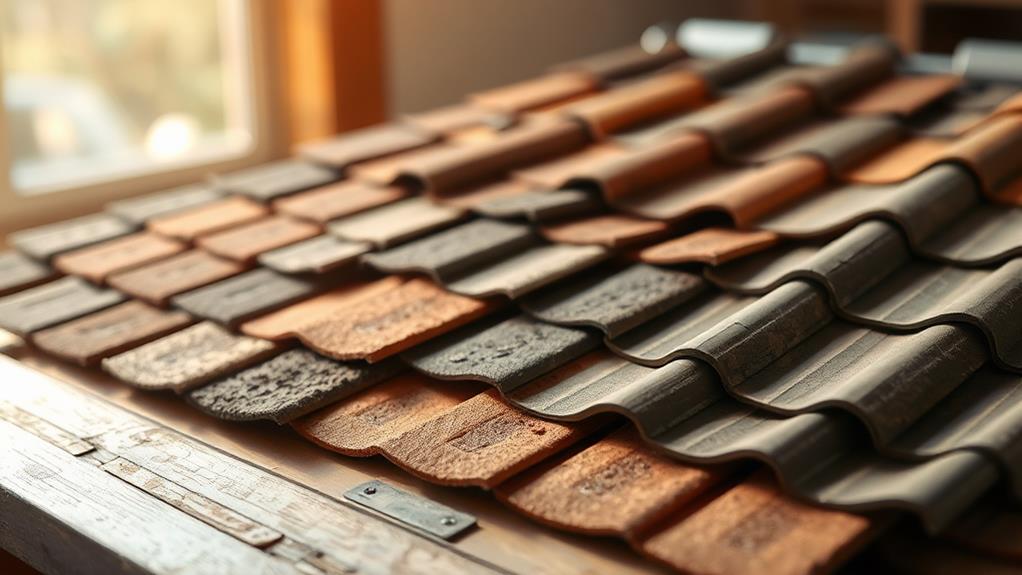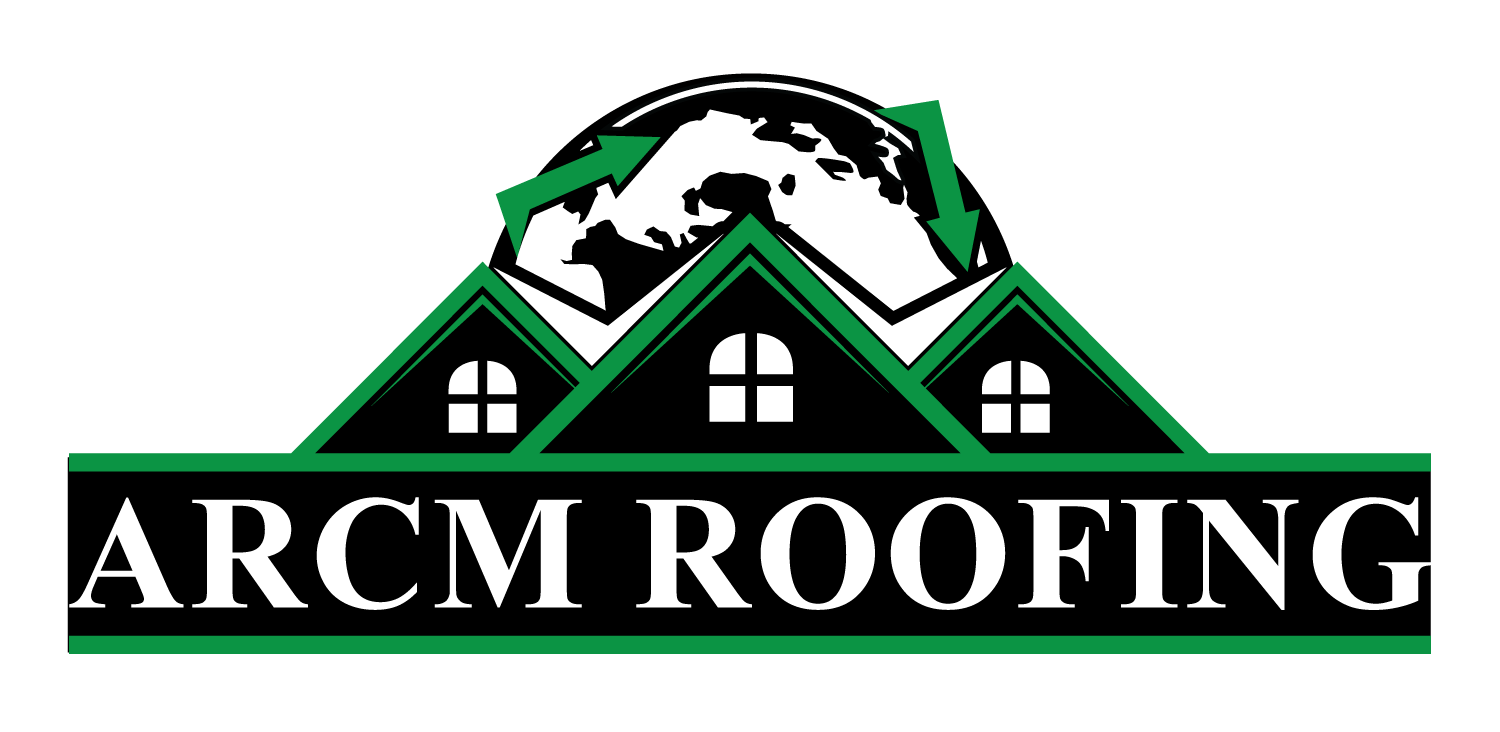The residential roof replacement process starts with a detailed assessment of the roof's current condition, evaluating structural integrity, age, and any existing damage, including missing shingles and leaks. This assessment informs the material selection, which considers climate, durability, and aesthetic alignment with your home. Following this, professional installers meticulously remove the old roof and install the new materials, ensuring proper integration and long-term durability. Each step is tailored to your home's unique needs, considering both functionality and visual appeal. For those interested, further exploration reveals the benefits of such investments and the variety of material lifespans available.
Roofing Highlights
- Conduct a thorough assessment to evaluate the roof's structural integrity and identify existing damage.
- Choose materials based on climate, budget, durability, and maintenance expectations for optimal performance.
- Plan the installation timeline to align with favorable weather and homeowner's schedule.
- Professional removal of the old roof and installation of new materials ensures long-term durability.
- Select roofing solutions that enhance home value, aesthetics, and resilience against weather conditions.
Replacing Your Roof Entail

Initiating a roof replacement commences with a thorough initial roof assessment to identify any underlying structural issues that may require attention before proceeding. It's important to consider storm damage repair if applicable, as this will inform necessary repairs prior to replacing your roof.
Following this critical step, the material selection process becomes paramount, as it involves evaluating various options taking into account factors such as durability, aesthetics, and budget constraints. Professional roofing contractors, like those serving the Denver area, often provide access to 83% impact resistant materials to guarantee longevity.
Once these foundational decisions are made, the installation timeline is mapped out in detail, outlining each step to ensure a seamless transition from old to new roof, minimizing disruptions while maximizing efficiency.
Initial Roof Assessment
A thorough initial roof assessment is a vital first step in the roof replacement process. This evaluation not only establishes a foundational understanding of the roof's current state but also aligns the client's aspirations with practical solutions to address varied needs and concerns.
Conducted by seasoned professionals, the assessment considers key factors such as the structural integrity, age, and existing damage of the roof, including signs of wear like missing or damaged shingles, leaks, or sagging.
The inspection process serves as a blueprint for the subsequent replacement efforts, allowing homeowners to make informed decisions. Detailed observations and measurements are documented, evaluating not just the roof's exterior layers, but extending into areas beneath, like decking and ventilation systems which play a pivotal role in the roof's long-term performance.
Clients engage with this extensive process, gaining insights that foster a sense of trust and community belonging. The meticulous examination leads to personalized recommendations, ensuring each homeowner receives a tailored approach that respects the uniqueness of their home and lifestyle.
Material Selection Process
Selecting the right materials is a crucial facet of the roof replacement process, directly impacting the durability, energy efficiency, and aesthetic appeal of a home. The journey begins with understanding various materials available, each offering distinct advantages.
Asphalt shingles, for their cost-effectiveness and ease of installation, remain a popular choice. Metal roofs boast longevity and impressive resistance to weather extremes, yet they require a higher initial investment. Clay and concrete tiles offer a timeless aesthetic and excellent thermal properties, ideal for specific architectural styles, albeit at the cost of substantial weight considerations.
Given the importance of material selection, homeowners are encouraged to iterate considerations, including local climate conditions, budget constraints, and maintenance expectations. Durability, energy efficiency ratings, and warranties further guide this pivotal decision-making process.
The selection of materials contributes to the home's architectural integrity, ensuring harmony with its surroundings. Engaging with roofing experts to tap into their knowledge and seeking community feedback are prudent steps for ensuring that choices resonate with both personal preferences and environmental conditions. Ultimately, through informed, thoughtful decisions, homeowners not only enhance their property's value but also foster a sense of belonging within their community.
Installation Timeline Steps
Traversing the installation timeline for a roof replacement involves several methodical steps, pivotal for guaranteeing efficiency and effectiveness throughout the project. The journey begins with a comprehensive assessment of the existing roofing system, allowing contractors to identify potential underlying issues and anticipate any additional needs that may arise. This critical step ensures a tailored approach, considering each unique residential structure's requirements.
Following the assessment, the scheduling phase comes into play, aligning the installation process with favorable weather conditions while accommodating the homeowner's timeline. This synergy between natural and logistical elements helps minimize disruptions and enhance satisfaction.
Upon commencement of the project, the existing roof is carefully removed, with attention given to preserving the structural integrity beneath. This meticulous dismantling is an essential precursor to a successful installation.
Subsequently, the installation phase introduces the previously selected materials, ensuring precise measurements and alignment. Professional craftsmanship guarantees that each element is seamlessly integrated, fostering durability and aesthetic appeal.
Benefits

Undertaking a residential roof replacement not only enhances the aesthetic and market value of your home but also considerably improves its energy efficiency by providing better insulation and reducing energy costs.
A new roof provides ideal protection against harsh weather conditions, ensuring increased durability and safety. This upgrade also extends the lifespan of your roofing system.
Enhanced Home Value
Investing in a new roof not only bolsters the structural integrity of a home but also profoundly enhances its market value. As a cornerstone of curb appeal, a well-maintained roof acts as a visual representation to the durability and care invested in a home, instantly reassuring potential buyers. The impact on property value is significant, as astute homeowners understand that a new roof is emblematic of reduced future maintenance costs and the alleviation of weather-related concerns, which are often pivotal in negotiation dynamics during sales.
In addition, the aesthetic upgrade that a replacement roof offers cannot be understated; it complements exterior design, aligns with contemporary architectural trends, and fosters a sense of pride and belonging within a neighborhood.
In real estate markets, where first impressions carry substantial weight, a new roof distinguishes a property amidst the competitive landscape. It signals that the home is a reliable investment, thereby increasing its desirability and competitive market edge. Additionally, with certification or warranties typically accompanying modern roofing materials, buyers may find themselves reassured of long-term safety and stability, further justifying a willingness to pay a premium price. Accordingly, roof replacement is more than an enhancement; it is a strategic investment in augmented property value.
Improved Energy Efficiency
A new roof plays a pivotal role in enhancing a home's energy efficiency. By incorporating advanced materials and innovative technologies, contemporary roofing solutions greatly reduce energy consumption and promote sustainable living. Homeowners increasingly seek roofing materials with high thermal resistance, minimizing heat transfer and maintaining stable indoor temperatures. Reflective coatings and energy-efficient shingles are prime examples of such advancements, reflecting more sunlight and absorbing less heat compared to traditional materials. This reduction in heat gain not only lessens the burden on air conditioning systems but also contributes to lower energy bills, embodying responsible environmental stewardship.
Moreover, improved energy efficiency extends beyond mere material choice; it encompasses the entire roof system's design and installation process. Proper ventilation is essential in mitigating heat build-up in attic spaces, preventing moisture accumulation, and enhancing overall climate control within the home. A well-insulated roof complements these efforts, forming a thorough barrier against external temperature fluctuations and improving comfort levels throughout the year. For communities valuing collective efforts towards sustainability, investing in an energy-efficient roof fosters a shared sense of responsibility, ensuring that all members contribute positively to environmental preservation while enjoying the synergy of reduced operational costs.
Increased Durability and Safety
Enhancing the durability and safety of a residential roof provides significant long-term benefits to homeowners. In the context of roof replacement, selecting materials that are robust and resilient against weather extremes is essential. High-quality materials, like impact-resistant shingles or metal roofing, are engineered to withstand harsh conditions, including heavy winds, hail, and intense sunlight, thereby extending the lifespan of your roof.
Beyond the practical aspects, a durable roof guarantees peace of mind, reducing the frequency of repairs and unexpected costs, fostering a sense of security within the household.
Safety is another paramount aspect of a well-replaced roof, creating an environment resilient to external threats and internal hazards. Fire-resistant materials and proper ventilation systems contribute to a safer home, protecting families from potential dangers. Additionally, a well-sealed roof prevents moisture entry, which can lead to structural degradation or mold growth, ensuring the integrity and health of living spaces.
In essence, investing in a durable and safe roof not only nurtures a sense of belonging by protecting one's home—a symbol of family's unity—but also aligns with a long-term strategic approach to safeguarding one's most valuable asset. Consequently, a thorough roof replacement process is fundamental in fortifying one's domicile.
Material Lifespan Details

Understanding the lifespan of various roofing materials is essential for homeowners considering a roof replacement, as it provides valuable insight into long-term durability and maintenance requirements. Factors such as climate conditions, installation quality, and material resilience play significant roles in determining how long a roof will withstand the elements. The table below offers a comparative analysis of common roofing materials in regard to lifespan, durability, and maintenance needs.
| Material | Average Lifespan | Maintenance Needs |
|---|---|---|
| Asphalt Shingles | 15-30 years | Moderate |
| Wood Shingles | 20-25 years | High |
| Metal Roofing | 40-70 years | Low |
| Slate Tiles | 75-100+ years | Low |
| Clay Tiles | 50-100 years | Moderate |
Common Roofing Materials Lifespan
When selecting roofing materials for residential replacement, considering their lifespan is essential to guarantee long-term performance and value. A well-chosen material not only enhances the beauty and protection of the home but also instills a sense of security and belonging within its residents, knowing their investment is sound.
Asphalt shingles, a common choice due to their affordability and ease of installation, typically last between 20 to 30 years, depending on environmental conditions and upkeep. Metal roofing, known for its durability and resistance to harsh weather, offers a considerably longer lifespan, often ranging from 40 to 70 years. This longevity comes from materials such as aluminum and steel, which are less prone to corrosion.
For those seeking a timeless aesthetic, clay or concrete tiles present an appealing option, delivering lifespans that can stretch from 50 to well over 100 years when properly maintained. These materials resist fire and damage from the elements, offering peace of mind to their owners. In contrast, wood shake roofs, while offering a natural charm and insulation benefits, typically endure for 30 to 40 years, contingent upon regular maintenance and suitable climate conditions. Every choice reflects not only practicality but also a commitment to enduring residential satisfaction.
Factors Affecting Material Longevity
Frequently overlooked, several factors considerably influence the longevity of roofing materials, impacting their overall performance and durability. Environmental conditions play a pivotal role; areas prone to intense sunlight, heavy rainfall, or severe temperature fluctuations may accelerate material degradation. Coastal regions, characterized by high humidity and salt exposure, pose additional threats to material integrity.
Additionally, the orientation of the roof—influencing exposure to sun, wind, and precipitation—significantly affects wear and tear patterns.
It's also critical to contemplate the quality of installation. Proper installation guarantees that materials function optimally and are not prematurely compromised by structural weaknesses or water infiltration. The expertise of the installation team not only reflects on the immediate aesthetic and functional outcome but also on the long-term resilience of the roofing system.
Furthermore, the choice of materials should align with the specific climatic conditions and architectural styles prevalent in the area. High-quality materials, though initially more expensive, often offer enhanced durability, reducing the frequency of repairs or replacements. Consequently, understanding these variables allows homeowners to make informed decisions, fostering a sense of community through shared insights and experience-based recommendations, ultimately achieving more sustainable and enduring roofing solutions.
Comparing Durability and Maintenance
The lifespan of roofing materials varies considerably, influenced by inherent durability and the maintenance they demand. While traditional asphalt shingles may serve a household for 15-30 years with minimal maintenance, they necessitate regular inspections to manage issues such as moss growth or granule loss.
This contrasts with materials like clay tiles or metal roofs, both known for their longevity—often exceeding 50 years. However, their resilience does not eliminate the need for attentive upkeep. Clay tiles, despite their toughness, require periodic cleaning to prevent algae build-up, while metal roofs, though resistant to severe weather conditions, can benefit from being treated to prevent corrosion.
For homeowners who seek permanence and reduced maintenance, premium materials like slate provide an unparalleled lifespan exceeding 100 years. While the initial investment is substantial, the resulting reduction in costs related to repairs and replacements over decades can present a compelling economic case. Yet, slate roofs must be routinely checked for broken tiles that could allow water penetration.
For those who value longevity without high maintenance, selecting materials requiring varying levels of care creates a sense of security and connection, ensuring their home remains not only a shelter but a durable sanctuary.
Connect With Us
Ready to transform your home with a stunning new roof? Our expert team is here to guide you through every step of the residential roof replacement process.
Don't wait any longer to enhance your home's curb appeal and protect it from the elements. Connect with us today for a free consultation and see how we can elevate your home to new heights.
Call us at (303) 306-8384 and let's get started on your roofing journey!
Roofing FAQ
How Can I Tell if My Roof Needs a Full Replacement Instead of Repairs?
Determining whether a roof requires full replacement instead of repairs involves ascertaining factors such as extensive shingle damage, persistent leaks, and underlying structural issues. Consulting a professional can provide clarity and safeguard the safety and longevity of your home.
What Are the Steps Involved in Obtaining a Roofing Permit?
Obtaining a roofing permit involves identifying local building codes, completing necessary applications, submitting architectural plans, paying associated fees, and scheduling inspections. This process guarantees safety compliance and fosters a sense of communal responsibility and trust.
Are There Specific Weather Conditions That Delay the Roof Replacement Process?
Adverse weather conditions such as heavy rain, strong winds, or extreme temperatures can delay roof replacement. These conditions compromise safety and efficacy, emphasizing the importance of clear communication between homeowners and roofing professionals to guarantee efficient project completion.
How Can I Prepare My Home and Yard Before the Roofers Arrive?
To prepare for the arrival of roofers, secure outdoor furniture, remove fragile items from walls, trim overhanging branches, and guarantee clear access to the roof. Embrace collaboration by communicating with neighbors about expected noise and disruptions.
What Should I Do if I Discover Unexpected Issues During Roof Replacement?
Upon discovering unforeseen issues, immediately communicate with your contractors to reassess the project scope. Trust their expertise for reevaluation and collaboratively discuss potential solutions, ensuring adjustments align with your budget and timeline while maintaining project integrity.




